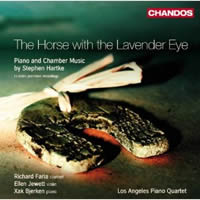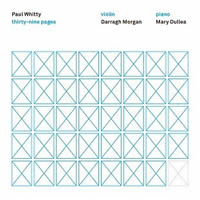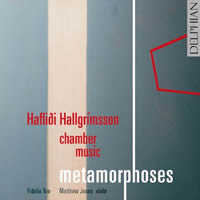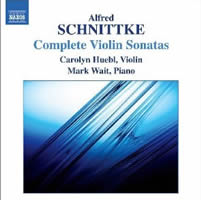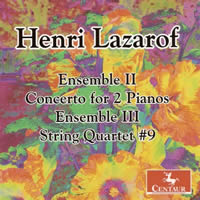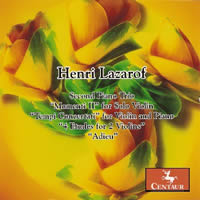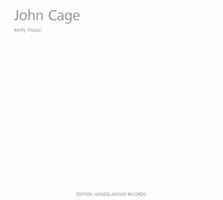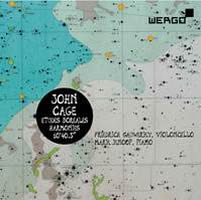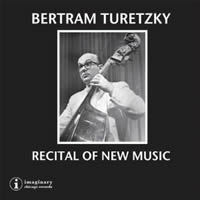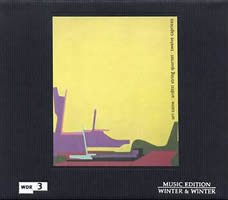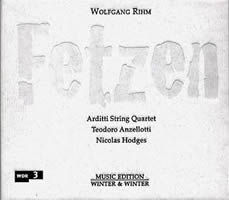String Theory 5: Sometimes with Piano
|
Grant Chu Covell [September 2011.]
Stephen HARTKE: The Horse with the Lavender Eye (1997)1; Selections from ‘Post-modern Homages’ (1984-92)2; Sonata for piano (1997-98)3; The King of the Sun (1988)4. Henrique OSWALD: Estudo-Scherzo (1902)5. Richard Faria1 (clar), Ellen Jewett1 (vln), Xak Bjerken1, 2, 3, 4, 5 (pno), Los Angeles Piano Quartet4: Michi Wiancko (vln), Katherine Murdock (vla), Peter Rejto (vlc), Xak Bjerken (pno). Chandos CHAN 10513 (1 CD) (http://www.chandos.net/). Distributed in the US by Naxos (http://www.naxos.com/). First heard ages ago in concert, Hartke’s violin duo Oh Them Rats is Mean in My Kitchen (1985) made a lasting impression — the same players, Michelle Makarski and Ronald Copes, recorded it on New World Records 80391. Beyond the inviting titles — the last episode of The Horse with the Lavender Eye is Cancel My Rumba Lesson and Personages in the night guided by the phosphorescent tracks of snails and Dancer listening to the organ in a Gothic cathedral appear in The King of the Sun — Hartke would fit well on a program of Messiaen and Stravinsky. Horse’s four episodes for clarinet, violin and piano deal with physical imbalance: The first movement asks the group to play only with their left hands. Gentle nostalgia warms the three-movement piano sonata and a handful of small genre pieces, including a Gymnopédie No. 4, and a variant on an etude by Oswald (1852-1931) whose original appears too.
Paul WHITTY: Thirty-Nine Pages (2005-07). Darragh Morgan (vln), Mary Dullea (pno). Metier msv25809 (1 CD) (http://www.divine-art.com/). I am eager to discuss Whitty’s Thirty-Nine Pages for two reasons: I’ve toyed with similar compositional strategies and I cannot endure Franck’s violin sonata. Whitty has taken Henle’s Urtext of Franck’s Sonata for Violin and Piano and reorganized and filtered each page. He allows that each resulting page, or movement, may be played in any combination and in any order. A majority occupies less than a minute each, and only a few exceed four. Generally each movement relates to a specific page, but two combine, and one appears to embrace all. This 38-track offering takes just over an hour. The first track, Page Five, finds the pair quietly alternating a high and low note for 2:52. I did not count the instances of this volley. It would be very difficult to discern Franck at this page’s core. The austerity suggests minimalism and spacious Feldman. Other pages take similar routes, and one simply flicks out descending scales. Sometimes Romantic chords or tonal passages emerge, like the scrappy Page Eighteen or the cadence preserved in Page Ten. I find the original Franck excessively opulent and sometimes grotesque, and admit I take pleasure in Whitty’s endeavor because the original has been defaced. Would I enjoy the work if the composer hadn’t divulged his scheme? No, perhaps not as extensively, despite Morgan and Dullea’s commitment and finesse.
Hafliði HALLGRÍMSSON: Notes from a Diary, Op. 33 (2005)1; Seven Epigrams, Op. 23 (1996)2; Metamorphoses, Op. 16 (1994)3. Matthew Jones1 (vla), Fidelio Trio: Darragh Morgan2, 3 (vln), Robin Michael2, 3 (vlc), Mary Dullea3 (pno). Delphian DCD34059 (1 CD) (http://www.delphianrecords.co.uk/). Distributed in the US by Allegro Music (http://www.allegro-music.com/). I had wanted to reconcile this music with a brief visit to Iceland and look for lava and glaciers. Hallgrímsson once occupied the principal cellist’s chair in the Scottish Chamber Orchestra and considers himself a Northern European citizen. Concentration dictates Notes and Seven Epigrams’ multiple movements, predominantly minor-mode, neither dissonant nor depressing. In between trills and tremolos, we catch spectral effects such as in diary note No. 7 where the viola noodles over a multi-octave sustained piano chord. Seven Epigrams commemorates 20th-century Russian writers Hallgrímsson admires. The piano trio Metamorphoses stands decidedly apart from Strauss with brooding, gradual mutations.
Alfred SCHNITTKE: Violin Sonata No. 1 (1963); Violin Sonata No. 2, “Quasi una Sonata” (1968); Violin Sonata No. 3 (1994); Violin Sonata (1955). Carolyn Huebl (vln), Mark Wait (pno). Naxos 8.570978 (1 CD) (http://www.naxos.com). I can no longer approach Schnittke without being reminded of his outstanding film scoring fluency and the desolate and forlorn Ninth. These works traverse approximately 40 years and an aesthetic catalog. The First Sonata could hide well among other mid-century Soviet works which alternate lyricism and dance-hall pastiche. The Second Sonata’s nose-thumbing tweaks the genre. An exaggerating Gidon Kremer effectively owns Quasi una Sonata (and its orchestrated sibling) and it’s good to hear Huebl strive for civility. No. 3 comes at a varied career’s end. The four compact movements and restrained gestures in no way inhibit the music’s virulence. The set completes with a two-part student work, a No. 0 if you will, which suggests a pleasantry from the century’s start except for adventurous development.
Henri LAZAROF: Ensemble II for piano four-hands and string quartet (2005)1; Concerto for Two Pianos (2004)2; Ensemble III for two pianos and 2 violoncelli (2006)3; String Quartet No. 9 (2003)4. Ida Levin1, Lorenz Gamma1 (vlns), Andrew Duckles1 (vla), Ronald Leonard1, 3, Peter Meyers3 (vlc), Delores Stevens1, Ming Tsu1, Bernadene Blaha2, 3, Kevin Fitzgerald2, 3 (pno). Berganza String Quartet4: Aki Sunahara, Sabine Lier (vlns), Christof Kuen (vla), Katja Kuen (vlc). Centaur CRC 2949 (http://www.centaurrecords.com/). Distributed in the US by Qualiton (http://www.qualiton.com/). Henri LAZAROF: Second Piano Trio (2005)1; Momenti II for solo violin (2006)2; Tempi Concertati for violin and piano (2002-03)3; Four Etudes for Two Violins (2005)4; Adieu (2006)5. Christiane Edinger1, 2, 3, 4, 5, Adrien Iliescu4 (vln), Wolfgang Emanuel Schmidt1 (vlc), Klaus Hellwig1, 3 (pno). Centaur CRC 2948 (http://www.centaurrecords.com/). Distributed in the US by Qualiton (http://www.qualiton.com/). Except for their improvisatory structure, Lazarof’s modest, skillfully fashioned movements could have been penned a century ago. I wish the sparse notes provided more clues about the prolific composer’s intentions. Such small-scale free forms appeal vividly in the four two-violin Etudes, whereas the only item whose movements near the five-minute mark, Piano Trio No. 2, wanders aimlessly. Contrasting instruments reveal Lazarof’s strengths, as in Ensemble II whose five movements employ different lineups from the two pianos and string quartet roster. The six-movement Ninth Quartet shows its seniority affording greater intensity than the more recent solo string works, Momenti II and Adieu.
John CAGE: Dream (1948); In a Landscape (1948); Six Melodies (1950)*; Souvenir (1983). Edwin Alexander Buchholz (accord), Joanna Becker* (vln). Edition Wandelweiser Records EWR 0711 (1 CD) (http://www.timescraper.de/). I lose interest when these ambling, nearly tuneless works appear on piano. Buchholz’s Bugari Bayan Anatomic’s held tones improve mightily upon the keyboard’s decaying envelope, shrinking the 35-year distance between the opening Dream and closing Souvenir as if Cage had done nothing else in the interim. The accordion gently overshadows an undistinguished violin in Six Melodies. These compositions never top my Cage playlist, but I am glad to have heard them in these different guises.
John CAGE: Harmony XIII, XXIV, XXVII and XXII from Apartment House 1776 (1976; arr. Friedrich Gauwerky, 2009); two versions of Etudes Boreales (1978); 10’40.3” (1955; arr. F. Gauwerky, 2009). Friedrich Gauwerky (vlc), Mark Knoop (pno). Wergo WER 6718 2 (1 CD) (http://www.wergo.de/). Distributed in the US by Harmonia Mundi (http://www.harmoniamundi.com). Perhaps the contrast between Harmony’s gently fractured hymn tunes and Etudes Boreales’ avant-garde kitchen sink frolicking ought to reveal Cage’s diversity. Gauwerky and Knoop capably handle the contrasting styles, and Wergo nicely captures the extended effects. The Harmonies buffer the larger works and the abrupt mood changes merit smiles. Except to demonstrate versatility, I’m not sure why these might appeal to players and audience.
“Recital of New Music.” Charles WHITTENBERG: Electronic Study II with Contrabass (1962). William Jay SYDEMAN: For Double Bass Alone (1957). Kenneth GABURO: Two (1962)*. Ben JOHNSTON: Duo for flute and string bass (1963)**. George PERLE: Monody II for unaccompanied double bass (1962). Donald MARTINO: Cinque Frammenti for oboe and string bass (1961)***. Bertram Turetzky (cbs), Patrick Purswell*, Nancy Turetzky** (fl), Josef Marx*** (ob), Shirley Sudock** (sop), Gustav Meier** (cond.). Imaginary Chicago Records ICR 006 (http://www.imaginarychicago.com/). This reissue of a 1964 LP, purportedly the first release to feature the contrabass as soloist, can be enjoyed as a window onto decades past when contemporary music seemed scarier and its proponents had to appear resolute. Every bass player owes a debt to Turetzky. I am pretty sure it was at one of his recitals where I first heard Tom Johnson’s humorous and virtuosic Failing (1975). Today’s ears will expect something quite different in recording technology. Ripe with academic flavors, these works hug the 1960s start, and yet nearly 50 years later, Perle and Johnston’s 12-tone idiom isn’t that far from Gaburo’s intuitive response to Virginia Hommel’s poem. Within Martino’s five brief pieces we should admire the squawky oboe’s energy and the grumbling bass’s contours. I vastly enjoyed the bleepy effects in Whittenberg’s bass-plus-tape study. The label’s website provides the original notes.
Uri CAINE: Twelve Caprices (2010). Arditti String Quartet: Irvine Arditti, Ashot Sarkissjan (vlns), Ralf Ehlers (vla), Lucas Fels (vlc), Uri Caine (pno). Winter and Winter 910 171-2 (http://www.winterandwinter.com/). Wolfgang RIHM: String Quartet No. 12 (2000/01); Fetzen (1999-2004)1; Interscriptum, Duo für Streichquartett und Klavier (2000/04)2. Arditti String Quartet: Irvine Arditti, Ashot Sarkissjan (vlns), Ralf Ehlers (vla), Lucas Fels (vlc), Teodoro Anzelotti1 (accordion), Nicolas Hodges2 (pno). Winter and Winter 910 178-2 (http://www.winterandwinter.com/). These two pretty Winter and Winter products arrived together, and although I did not explore each sequentially, the chasm between them became impossible to miss. Its title ensures association with Paganini’s virtuosic whimsy; however, this dozen seems improvised and amateurish with the composer warming the piano bench while the Ardittis saw without enlightenment. I had not expected that the Rihm would consistently entrance. The Ardittis take up these “scraps” with delightful intensity. Long ago I abandoned the Minguet’s dreary Rihm quartet series on col legno. To my surprise, this Twelfth, a writhing 13:46, proved engrossing throughout. The Fetzen, presently eight in number, combine quartet and accordion, except for the first two for quartet and No. 4 which pairs viola and accordion.
Cage, Caine, Gaburo, Hallgrímsson, Hartke, Johnston, Lazarof, Martino, Perle, Rihm, Schnittke, Sydeman, Whittenberg, Whitty
[More Grant Chu Covell, String Theory]
[More
Cage, Caine, Gaburo, Hallgrímsson, Hartke, Johnston, Lazarof, Martino, Perle, Rihm, Schnittke, Sydeman, Whittenberg, Whitty]
[Previous Article:
Mostly Symphonies 18.]
[Next Article:
Liz Martin]
|
